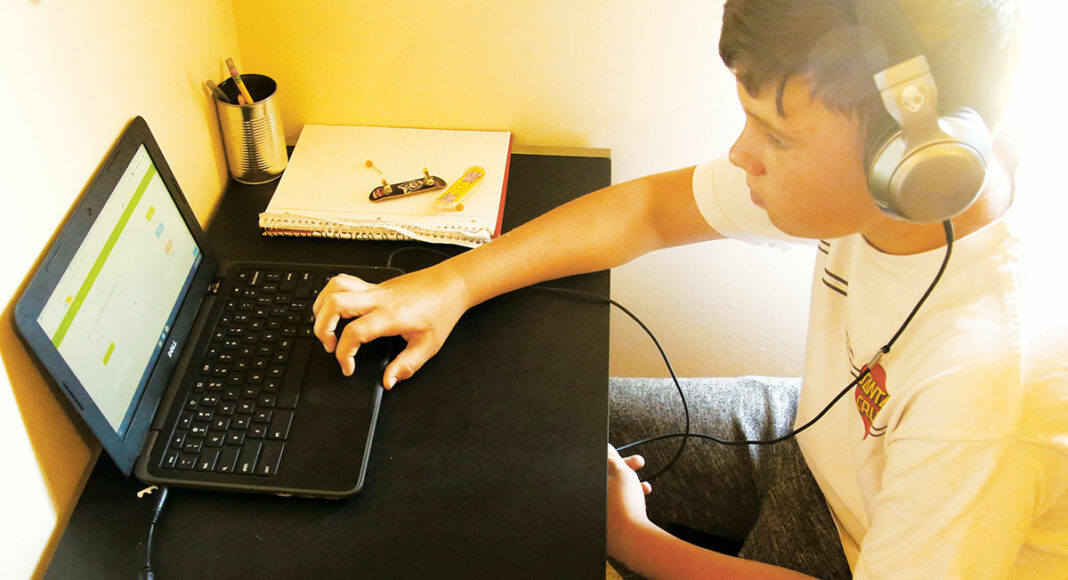Santa Cruz’s Jennifer Gallacher already had a busy schedule. She works a full-time job in the UCSC administration, and runs a small business, the Santa Cruz Rehearsal Studios, with her husband.
But since the Covid-19 pandemic hit, forcing schools to close and students to work from home in so-called distance learning, the couple have added a new job: de facto educators to their two kids, in fourth and seventh grade.
With strained timetables, frustrated kids and overloaded home internet, Gallacher says it is difficult to devote enough time to both work and kids.
“I pretty much vacillate between feeling like I’ve gotten it under control, and that I’m a complete failure as a parent,” she says.
And it’s not just the adults that are feeling the strain of the shift to home learning. Her kids, she says, desperately miss the social aspect that comes with going to school.
Steve Wuerth, whose 6-year-old son is engaging in distance learning, says he’s frustrated by the decisions that are keeping students at home.
Businesses through the county are open, he says, so why are schools still shuttered? He says education is more than merely sitting and listening to teachers talk—it’s the sum total of teaching, hands-on experience and peer interactions that make up learning.
“He doesn’t just learn on his own,” says Wuerth. “He learns by watching everyone. You put it all together and you formulate who you are.”
When California Gov. Gavin Newsom released the state’s four-tier protocol for reopening on Aug. 27, Santa Cruz County soon reduced its numbers of Covid-19 cases and moved into to the red—or “substantial”–category.
Previously under the Blueprint for a Safer Economy, California’s purple “widespread” category all but prohibited schools from reopening.
But after spending two weeks under the less restrictive label–meaning the county’s number of new positive tests was down to 5-8% per 100,000 residents–schools can technically begin to allow students to return on Sept. 22.
But doing so immediately for any district would be a risky move. School superintendents must balance student and staff safety with directives from their own county health offices, and consider that the enormous complexity of reopening their schools could be compounded if their county moves back to a more restrictive category, says Santa Cruz County Superintendent of Schools Faris Sabbah.
It is unlikely that school will reopen on a large scale, he says.
“It has to be thoughtful, and it has to be sustainable,” says Sabbah. “Our approach has to be really well-thought out and not reactive, and I think that’s in the best interest of students and families and staff. The reality is that we’re still in a pandemic. So if we don’t do it carefully and widely, it could create an outbreak.”
The California Department of Education has a comprehensive list of criteria to help guide school districts in their decision making.
Students throughout the U.S.–40,000 in Santa Cruz County, according to Ed-Data–have been engaged in distance learning since early this year, when Covid-19 began to make its worldwide sweep and schools began to close their doors.
That has been a hardship for many parents, particularly those who work full-time, who found themselves unwittingly cast into the role of academic coach.
The shift has also been a strain on educators, who now have to reinvent the way they do their jobs.
“Our teachers have been working really hard,” Sabbah says. “We did a lot of preparation over the summer, but we were preparing for a hybrid learning environment, so the pivot to full distance learning happened at the end of July.”
While most students have adapted to the brave new world of coronavirus-era schooling, distance learning has taken a toll on some, Sabbah said.
“In some ways it’s had the deepest impact on our students who have educational needs, like our special education students or English learners,” he said. “For those students, it’s very difficult to create a comprehensive, effective distance learning program.”
District officials are also concerned about a different category of students: those who, for a host of reasons, are not participating in their virtual classes.
Pajaro Valley Unified School District this week began to hold small groups in “safe spaces” for those students, Superintendent Michelle Rodriguez says. That plan, if successful, is likely to expand, she adds.
“We will eventually need to bring back small subsets of special education students,” she says. “We have a commitment and a requirement to support not only special education students, but other students who are not participating in distance learning.”
According to Rodriguez, PVUSD is developing a Return to School Readiness Index, a comprehensive algorithm customized to each of the district’s 35 school sites that rates such factors as classroom air flow, signage, transportation and food service.
The index also looks at whether desks are spaced six feet apart, and if that is not possible, whether plexiglass shields separate students.
In addition, the district must be able to meet the state requirement to test 25% of its staff every two weeks–or all of them every two months–before she will consider reopening.
The district is taking direction from the Santa Cruz County Health Department, too, she says.
“As superintendent, my main focus is assuring that the system is ready,” Rodriguez says. “So if and when the health conditions are ready, we can move simultaneously. I don’t want us to be the last.”
Sabbah says that, as a parent of school-aged children, he understands the pressure parents are feeling. SCCOE, along with districts across the country, are hearing from parents and students frustrated by the distance model.
Still, he says that any decision regarding reopening–or staying with the current model–must be made judiciously.
“We’re looking at the science when it comes to safety and to our local health officers, and to the guidance we’re getting from the state,” he said. “This way we can provide the very best learning environment for our students.”













